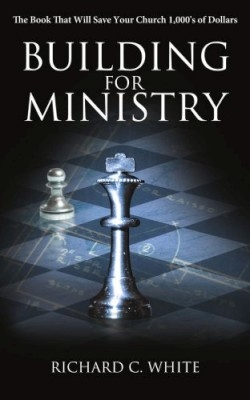Building for Ministry
Change isn’t easy especially for congregations embarking on building programs. Naysayers question every aspect of the budget and can even sabotage fund-raising and planning. Costly mistakes can be made unless the church has the wisdom to hire a church-building consultant to oversee and guide the process. Author Richard White heads such a consulting firm and has an extensive background in construction and pastoral ministry.
White knows from experience how committees should be structured to minimize conflicts so that plans can move forward. Defining a mission is important so that the building suits its intended purpose and he outlines a path to reach the goal. He suggests that the building committee consist of church members who understand the church vision and warns that “Unfortunately ‘experts’ on the committee often create more problems than they solve.” Once formed the committee needs to encourage “respectful discourse.”
White also discusses the thorny issue of fund-raising suggesting that the emphasis be on biblical stewardship rather than dollars. He gets into the nitty-gritty of loan applications and fees. Importantly he stresses that one of the biggest and most costly mistakes churches make is to start the process by hiring an architect or engineer. This can lead to cost overruns. From his vantage churches need a “seasoned” church-building consultant to represent them starting with the budget then working “backward to create a building design that fits the ministry mission and master plan.”
Despite the book’s warnings of potential pitfalls White is generous in his encouragement. When talking about methods of financing and problems that can arise among church members he suggests “embark on the journey with confidence and grace. This will result in God’s blessing on the members and project alike.”
White’s message could have been delivered in a more professional format. Fortunately unlike construction problems editing mistakes are more easily correctible especially with future printings. “Maize” should be spelled “maze” for example. The preferred spelling for “acknowledgment” isn’t used. There are double and triple spaces between sentences and words and lack of appropriate commas such as in direct address or clauses. Contrary to “book style” words and sentences are underlined for emphasis instead of italicized. An index or expanded table of contents would be useful to help locate key ideas. However the author does have a good summary at the end of each chapter and a place for notes helping stretch the number of pages.
Overall this slim volume should help churches avoid costly mistakes even if a church-building consultant is not hired. It’s a useful guide to getting the project done by building consensus organizing the right members of the congregation to lead committees defining vision and mission understanding the intricacies of financing working with experts and staying within budget. Even those who object to change may learn a lot.
Disclosure: This article is not an endorsement, but a review. The publisher of this book provided free copies of the book and paid a small fee to have their book reviewed by a professional reviewer. Foreword Reviews and Clarion Reviews make no guarantee that the publisher will receive a positive review. Foreword Magazine, Inc. is disclosing this in accordance with the Federal Trade Commission’s 16 CFR, Part 255.

